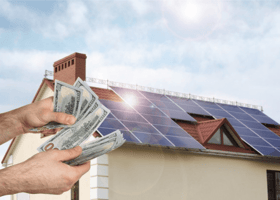Using the sun’s power to generate electricity is an incredible and sustainable way to meet your energy needs. Solar panels are a popular choice for homeowners looking for renewable sources of electricity that can reduce their carbon footprint, save money on utility bills, and help protect the environment.
But how much energy does a solar panel produce? In this blog post, Wolf River Electric explains exactly what you need to know about how much energy solar panels can provide and why it’s such a great renewable resource. We’ll look at various factors that affect output levels, such as orientation, size, efficiency rating, etc., so keep reading if you’re curious about harnessing the Power of Sunlight in your home.
Key Terms To Understand About Solar Output

Kilowatt (Kw)
A kilowatt (kW) is a unit of power that measures the rate at which electricity is generated or consumed. In the context of solar energy, it refers to the capacity or size of a solar panel system.
The higher the kW rating, the greater the electricity the system can produce. kW is a measure of instantaneous power and does not take into account the duration of usage.
Kilowatt Hours (Kwh)
Kilowatt hours (kWh) is a unit of energy that measures the amount of electricity consumed or generated over a specific period. It reflects the actual energy production or consumption over time.
For example, if a solar panel system consistently produces 1 kilowatt of power for 1 hour, it would generate 1 kilowatt hour (1 kWh) of energy. kWh is commonly used to measure and calculate electricity bills.
Direct Current Power (DC)
Direct current (DC) power refers to the type of electrical current produced by solar cells. Solar panels generate DC power from sunlight through a photovoltaic process. This DC power must be converted to alternating current (AC) power for homes and businesses.
An inverter converts the DC power to AC power, the standard form of electricity used in most appliances and electrical systems.
Go Solar Today!
How Much Energy Will An Entire Solar Panel System Produce?

On average, most residential solar panels can generate around 4-6 kilowatt-hours (kWh) per day per kilowatt of installed capacity. Therefore, a 5 kW solar panel system could produce approximately 20-30 kWh per day, or about 600-900 kWh per month, under optimal conditions. All in all, actual energy production may vary based on specific factors and seasonal variations.
Factors That Determine Solar Panel Electricity Production

Solar Panels Efficiency
Solar panel efficiency refers to the ability of solar panels to convert sunlight into electricity. Higher-efficiency panels can generate more electricity from the same amount of sunlight compared to lower-efficiency panels.
Efficient panels utilize advanced technologies and materials to maximize the capture and conversion of solar energy, resulting in increased electricity production.
Roof Angle And Tilt
Adjusting the panels to the appropriate angle helps ensure maximum exposure to sunlight throughout the day, optimizing energy production. Proper alignment with the sun’s position can significantly impact the overall performance of the solar panel system.
Solar Panel Age
Over time, solar panels may experience a decrease in efficiency due to wear and tear, environmental factors, and normal aging.
Aging panels may have reduced output and may require maintenance or, in some cases, replacement to maintain optimal performance and maximize electricity production.
Geographical Location
Areas with abundant sunshine and longer daylight hours typically experience higher solar energy potential, resulting in increased electricity generation.
Factors such as latitude, climate, and weather patterns influence the amount of sunlight available, which ultimately determines the solar panel system’s overall electricity production.
Maintenance
Dust, debris, or shading from vegetation can reduce the panel’s exposure to sunlight and hinder performance. Cleaning the panels periodically, inspecting for damage or malfunctions, and addressing any maintenance issues promptly can help maintain or enhance electricity production and extend the lifespan of the solar panel system.
Environmental Factors
Solar Irradiance: Solar irradiance refers to the intensity of sunlight reaching the Earth’s surface. Higher solar irradiance levels result in greater energy production from solar panels. Regions with high solar irradiance levels typically experience more significant electricity generation potential.
Temperature: While solar panels can still produce electricity in cold temperatures, excessive heat can decrease efficiency. Elevated temperatures can lead to a slight reduction in electricity production, highlighting the importance of proper ventilation and cooling mechanisms for optimal performance.
Shading: Shadows cast on solar panels, whether from nearby buildings, trees, or other objects, can significantly reduce their output. Minimizing or eliminating shading is crucial for maximizing energy production and ensuring the efficiency of the solar panel system.
Calculating How Much Energy A Solar Panel Produces

The wattage rating of the panel is a key indicator, representing the maximum solar power it can generate under specific conditions. The panel’s efficiency, sunlight availability, and environmental factors impact energy production.
To estimate energy output, the wattage rating is multiplied by the number of hours of sunlight received per day. For example, a 300-watt solar panel receiving 5 hours of sunlight may produce 1,500 watt-hours or 1.5 kilowatt-hours (kWh) of energy per day.
Why Does Solar Panel Output Matter

Understanding the output helps in sizing the system appropriately and estimating the financial and environmental benefits. A higher output allows for greater energy self-sufficiency and potential savings on utility bills.
It also impacts the feasibility of offsetting carbon emissions and reducing reliance on traditional energy sources. Solar panel output plays a significant role in evaluating the system’s performance and long-term viability.
Solar Panel Output And Cost
Higher output panels are generally more expensive due to their advanced technology and increased efficiency. However, they may offer better long-term returns on investment by generating more electricity and potentially reducing the payback period.
Choosing panels with the desired output involves balancing the initial cost with the expected energy production.
We advise you to consider the specific energy needs, available space for installation, and financial goals when determining the optimal solar panel output and its associated cost.
The Effect Materials Have On Output
Different types of solar panel technologies, such as monocrystalline, polycrystalline, or thin-film, have varying performance characteristics. Monocrystalline panels, made from a single crystal structure, typically offer higher efficiency and output. Polycrystalline panels, composed of multiple crystal structures, are slightly less efficient but can be more cost-effective.
Thin-film panels are less efficient but offer flexibility and can perform better in low-light conditions. Understanding the effect of materials on output helps in selecting the most suitable solar panel technology for specific energy needs, space availability, and budget constraints.
Explore Your Solar Options With Wolf River Electric!

And there you have it. With Wolf River Electric’s various solar options, you can find the right fit for your home. Whether you want energy savings or renewable energy, we’ve got you covered.
As you make the steps towards getting a solar system installed, always remember to build relationships and ask around so that you can make an informed decision. When selecting a system, ask yourself how many panels you’ll need for your home or office space and calculate how much energy each can produce.
Don’t worry if something still proves difficult; at Wolf River Electric, we have the expertise and resources needed to help guide you through the process.
Frequently Asked Questions
Can Solar Panels Produce Energy On Cloudy Days?
Solar panels can still generate electricity on cloudy days, although their output may be reduced. While direct sunlight is ideal for maximum energy production, solar panels can still capture diffuse sunlight and convert it into electricity. However, the power output will be lower than on bright, sunny days. Cloud cover decreases the intensity of sunlight reaching the panels, impacting how much electricity they can produce.
What Happens To Excess Energy Produced By Solar Panels?
When solar panels produce more energy than you currently require, the excess energy is typically fed back into the electrical grid. This process is known as net metering or grid-tied systems. In such cases, your electric utility may credit your account for the surplus electricity you generate, effectively offsetting your future energy consumption. Some regions also offer feed-in tariff programs, where you can sell the excess energy back to the grid for financial compensation.
How Much Energy Do Solar Panels Produce Per Hour?
The energy production of solar panels is measured in kilowatt-hours (kWh) rather than per hour. The specific energy output per hour depends on various factors, such as the capacity and efficiency of the solar panels, sunlight availability, and environmental conditions. An average solar panel system can generate around 4-6 kWh per day, or approximately 0.17-0.25 kWh per hour, under optimal conditions.
How Many Solar Panels Do I Need For 1000 Kwh Per Month?
One solar panel of 1 Kw can produce approximately 100-150 kWh per month. Therefore, to generate 1000 kWh per month, you would likely need a solar panel system with a capacity of around 6-10 kW. It’s advisable to consult with a solar energy professional to determine the system size based on your specific requirements accurately.
Can You Increase The Output Of Your Solar System?
First, ensuring optimal panel orientation and tilt helps maximize sunlight absorption. Regular cleaning and maintenance of the panels also improve their efficiency. Additionally, adding more solar panels to your system or upgrading to higher-efficiency panels can increase energy production.
Join Our Solar Community
Get exclusive access to the latest solar news, tips, and promotions!


